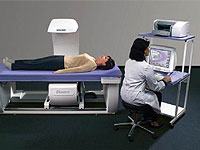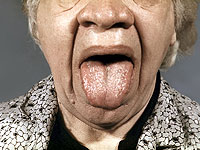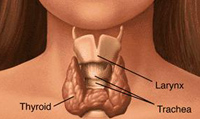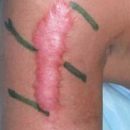The reasons for overpressing the growth hormone in the disease acromegaly, the symptoms of which are manifested by an increase in stop, brushes, facial bones are not sufficiently studied. How unmistakably and at what stage determine that this is a rare disease exactly acromegaly? Diagnostics and signs - more in the article.
Content
 Symptoms and causes of acromegaly, the symptoms of which is the degradation of the person, a high height and disproportionate body, today not fully studied. Medicine describes certain cases of this disease associated with injury, mental disorder, chronic infection. Sometimes pathological pregnancy and childbirth are an impetus for the development of acromegaly. Diagnosis of the disease is based on the detection of increased level of somatotropic hormone in the blood and radiographic confirmation of the tumor.
Symptoms and causes of acromegaly, the symptoms of which is the degradation of the person, a high height and disproportionate body, today not fully studied. Medicine describes certain cases of this disease associated with injury, mental disorder, chronic infection. Sometimes pathological pregnancy and childbirth are an impetus for the development of acromegaly. Diagnosis of the disease is based on the detection of increased level of somatotropic hormone in the blood and radiographic confirmation of the tumor.
Signs of acromegaly are manifested as follows:
- coarse, large features;
- sweating and amplification of metabolism;
- deformation of the joints under the action of increasing weight;
- apnea in a dream;
- arterial hypertension.
At a certain stage of development, it can be noted that the features of a person become pretty large and rude. The increase in the size of internal organs and hands, stop, facial bones is accompanied by deformation of the joints, as well as a violation of metabolism, which entails increased excessive sweating and raising blood pressure. Most often, the cause of this disease should be sought in connection with the pituitary tumor and disruption of the endocrine system. The pituitary cells that produce a somatotropic hormone for certain reasons begin to multiply faster, and growth hormone is more active than the norm. Over time, the adenoma of the pituitary is formed, and the disease in its development passes the consistent stages:
- Precoomegalic — detected rarely;
- Hypertrophical — It is a bright deployed picture of the disease;
- Tumor — manifested by signs of the effect of tumor on neighboring bodies;
- Cahlectic stage, as the outcome of the disease.
Mortality due to acromegaly is associated with the lesion of brain vessels, heart and lung disease.
Signs of acromegaly
 The development of the disease begins slowly, meets in men, but more often in women aged 18-35 years. The general weakness appears, a violation of sensitivity in hand, there is noticeable disproportionateness, high growth and change of face form: the nose, the lower jaw increases, the cheeks, ears and abnormal arcs change. Become thick and very large lips, the language increases and hardly places in the mouth, characterized thickening of the skin of the forehead and nose. Enhanced hair growth and the change in their structure, a significant increase in the foot and brush, especially in transverse. Patients in the initial stage of the disease are noted by increased fatigue, strong headaches, vision disorder, visual acuity is noticeably reduced and the field of view is narrowed, the increase in muscle force is further replaced by weakness and reduction of muscle volume. The progression of the disease in the absence of proper treatment is manifested by cardiac and pulmonary failure with an increase in blood pressure.
The development of the disease begins slowly, meets in men, but more often in women aged 18-35 years. The general weakness appears, a violation of sensitivity in hand, there is noticeable disproportionateness, high growth and change of face form: the nose, the lower jaw increases, the cheeks, ears and abnormal arcs change. Become thick and very large lips, the language increases and hardly places in the mouth, characterized thickening of the skin of the forehead and nose. Enhanced hair growth and the change in their structure, a significant increase in the foot and brush, especially in transverse. Patients in the initial stage of the disease are noted by increased fatigue, strong headaches, vision disorder, visual acuity is noticeably reduced and the field of view is narrowed, the increase in muscle force is further replaced by weakness and reduction of muscle volume. The progression of the disease in the absence of proper treatment is manifested by cardiac and pulmonary failure with an increase in blood pressure.
Experts of endocrinologists, oculists, neurologists and neurosurgeons when examining patients noted the weakening of mental abilities, violation of the function of the genital glands — All this manifestations of signs of acromegaly. Women has a disruption of the menstrual cycle and the release of milk from the mammary glands, secondary infertility, men have a decrease in potency. The growth of the tumor is accompanied by drowsiness, thirst, increasing the frequency of urination and the volume of separated urine, sharp differences in body temperature, the possible development of epilepsy.
Treatment of acromegaly
Timely and adequate treatment allows you to hope for a prosperous outcome and possible recovery, in the absence of treatment and severe disease — Forecast unfavorable. A set of therapeutic measures includes:
- removal of the pituitary tumor;
- Treatment aimed at reducing the level of somatotropic hormone.
The appearance of characteristic changes in appearance — This reason to suspect the acromegaly and urgently consult a doctor. Long-term increased concentration of growth hormone in the blood leads to early disability and mortality from pulmonary or heart failure. Modern methods of treatment with the use of radiation and hormone therapy make it possible to eliminate excessive allocation of growth hormone and thus facilitate the patient's condition.









